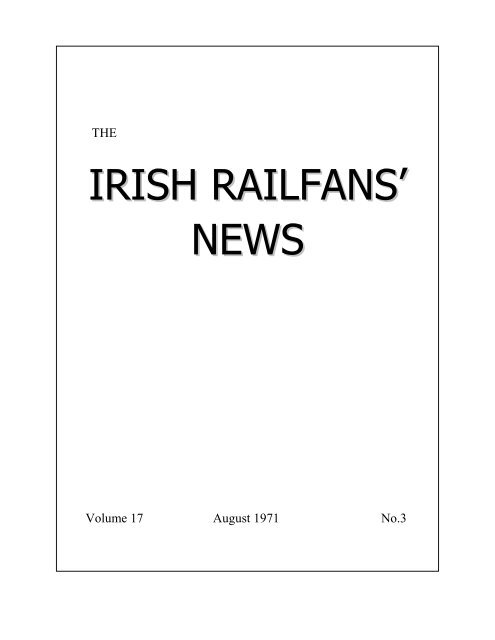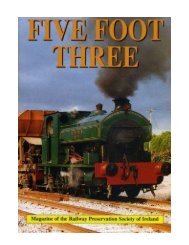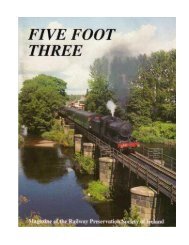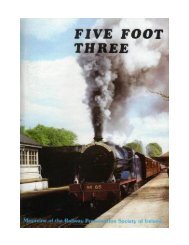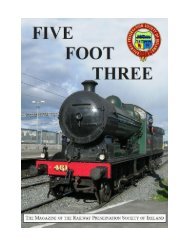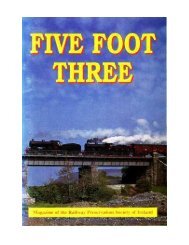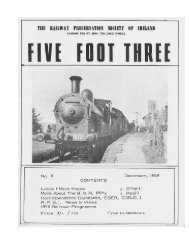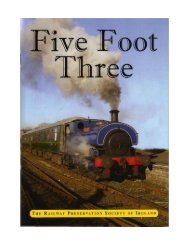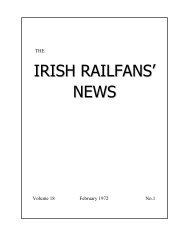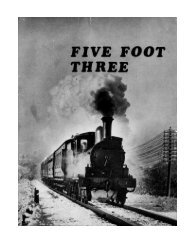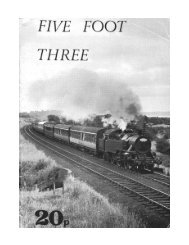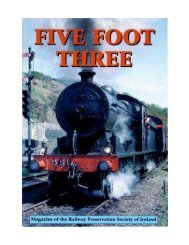No.3 - Steam trains on Irish Railways with RPSI - Railway
No.3 - Steam trains on Irish Railways with RPSI - Railway
No.3 - Steam trains on Irish Railways with RPSI - Railway
Create successful ePaper yourself
Turn your PDF publications into a flip-book with our unique Google optimized e-Paper software.
THEIRISH RAILFANS’NEWSVolume 17 August 1971 <str<strong>on</strong>g>No.3</str<strong>on</strong>g>
THE IRISH RAILFANS’ NEWSVolume 17 August 1971 <str<strong>on</strong>g>No.3</str<strong>on</strong>g>Managing Committee:C.D. SeymourB.J. PenderP.J. FlanaganR.C. FlewittG.M. D’ArcyEDITORIALWith so much discussi<strong>on</strong> currently going <strong>on</strong> about “going into Europe”, both in Ireland and GreatBritain, it is interesting to be able to report that in <strong>on</strong>e small way CIÉ have already made that move.Their new train timetable, which came into force <strong>on</strong> 6 June and which will operate until 3 June 1972,has been completely recast in respect to its layout and it is now printed in accordance <strong>with</strong> the more orless standard format used by the majority of European railways. To the majority of users of the booklet,the use of certain symbols will take some getting used to, but for those using such documents regularlythe changes are most welcome.A large number of CIÉ <str<strong>on</strong>g>trains</str<strong>on</strong>g> are “summer <strong>on</strong>ly” services and as the timetable runs for a year there arenecessarily lots of footnotes about dates of operati<strong>on</strong>. In the new layout full marks must be given to thecompilers as the notes are far clearer than they have ever been before. Another most welcomeimprovement is the use of different symbols to indicate the extent of the meal service available <strong>on</strong> thevarious <str<strong>on</strong>g>trains</str<strong>on</strong>g>, including the “in-seat catering” for first-class passengers provided <strong>on</strong> certain <str<strong>on</strong>g>trains</str<strong>on</strong>g>.Two other innovati<strong>on</strong>s are the showing of distances between stati<strong>on</strong>s in kilometres, and the provisi<strong>on</strong> ofa list of fares between principal stati<strong>on</strong>s. However, in regard to the latter, <strong>on</strong>ly single fares are shownand there is no indicati<strong>on</strong> whatsoever of the existence of any excursi<strong>on</strong> or weekend fares. Surely <strong>on</strong>esentence admitting that such fares exist could have been squeezed in somewhere in the timetable.While the improvements in the timetable are, as we have said, most welcome the booklet is not <strong>with</strong>outits faults. We may menti<strong>on</strong> some of them - not just to indulge in facile criticism for its own sake, but inthe hope that they may be noted for official correcti<strong>on</strong> in future issues. The “through carriage” symbolis used in a few places but it does not appear in many places where it would be relevant. The “Border”or “Customs” stati<strong>on</strong> indicati<strong>on</strong> is used, for instance, in the Rosslare/Le Havre steamer table <strong>on</strong> page 40but it is omitted <strong>on</strong> the Cork/Swansea table immediately underneath it <strong>on</strong> the same page, while it doesnot appear at all in the <strong>on</strong>e place where it would seem to be essential - the Dublin/Belfast tables. Withthe excepti<strong>on</strong> of the “Enterprise” and “Deiseach” expresses train names appear to have been dropped,as they do not appear <strong>on</strong> the relevant tables. But as they were seldom used by the public and rarelycarried by the actual <str<strong>on</strong>g>trains</str<strong>on</strong>g> this is not, perhaps, surprising.While we normally deal <strong>with</strong> actual service changes in our news pages, this time there is relatively littlein the way of alterati<strong>on</strong> and what changes there are may be summarised here. On the Wexford line the18:15 from Rosslare Harbour to Dublin runs all year round. To Waterford there are still <str<strong>on</strong>g>trains</str<strong>on</strong>g> at 18:00and 18:10 - surely to defer <strong>on</strong>e to say 19:00 or 19:30 would provide a more balanced service. In the updirecti<strong>on</strong> the positi<strong>on</strong> is nearly as bad, <strong>with</strong> <str<strong>on</strong>g>trains</str<strong>on</strong>g> leaving Waterford at 08:05 and 08:25. A welcomeinclusi<strong>on</strong> in the timetable are the Wexford/Rosslare Strand summer seaside <str<strong>on</strong>g>trains</str<strong>on</strong>g>, though for someunknown reas<strong>on</strong> neither the Drogheda/Laytown nor Cork/Youghal seaside <str<strong>on</strong>g>trains</str<strong>on</strong>g> appear. An interestingtrain is the 17:55 from Waterford to Wellingt<strong>on</strong> Bridge which brings home workers who reach
Waterford in the morning <strong>on</strong> the 07:15 ex Rosslare Harbour. Reports indicate good patr<strong>on</strong>age of thenew service.In sum, the timetable is vastly changed in appearance but not in c<strong>on</strong>tent. It will take some getting usedto, but its layout has been thought out well and should not need more than minor modificati<strong>on</strong>s. Awelcome feature is the route map in fr<strong>on</strong>t <strong>on</strong> which the appropriate table numbers are shown, andwhich is essential for any<strong>on</strong>e not familiar <strong>with</strong> the <strong>Irish</strong> railway network. But perhaps <strong>on</strong>e should havea little sympathy <strong>with</strong> the poor enthusiast, for the introducti<strong>on</strong> of train numbers for all services seemscertain to cause some c<strong>on</strong>fusi<strong>on</strong> in the ranks of those to whom 1752 meant the 5:52pm C<strong>on</strong>nollyStati<strong>on</strong>/Bray - not the 13:00 Howth/C<strong>on</strong>nolly Stati<strong>on</strong> (Sundays) as it does now!News Secti<strong>on</strong>More BullCÓRAS IOMPAIR ÉIREANNIn our last issue we described some of the c<strong>on</strong>fusi<strong>on</strong> caused <strong>on</strong> 9 March by a bullock <strong>on</strong> the Loop Lineand we promised to relate the chaos caused to the mainline <str<strong>on</strong>g>trains</str<strong>on</strong>g>. We do so by quoting ourcorresp<strong>on</strong>dent’s report:“The 18:20 Sligo, 18:45 Galway and 19:00 Westport were not seriously delayed, though the 15:10 exRosslare (B163, 3 bogies, HV and LV) was delayed about 20 minutes. It was <strong>on</strong>ly after 19:00 that thefull effects of the single-line working began to be felt. The 15:05 ex Sligo (A47R, SV, BV, 5 bogiesand HV) had dropped a staff at Killucan, causing about 30 minutes delay to the 14:50 ex Westport(B192, 5 bogies and HV) and the 15:50 ex Galway (B157, TPO, BV, 5 bogies and HV). These <str<strong>on</strong>g>trains</str<strong>on</strong>g>were further delayed at C<strong>on</strong>nolly Stati<strong>on</strong> and eventually arrived at Pearse Stati<strong>on</strong> at 19:53, 20:01 and20:20 - 63, 61 and 60 minutes late respectively.“On the Bray line the 18:35 ex Bray (A51R, 6 bogies and HV) terminated 9 minutes late at PearseStati<strong>on</strong>, while the 18:55 ex Dalkey arrived there at 19:37, 20 minutes late. The 19:00 ex Bray (A22R, 6bogies and HV) was delayed at Lansdowne Road and Bost<strong>on</strong> Sidings and arrived 37 minutes late atPearse. The 20:00 ex Bray arrived at C<strong>on</strong>nolly Stati<strong>on</strong> at 21:03. The 19:30 Heust<strong>on</strong>/Pier train (B149, 4bogies, HV and BV) passed Tara Street at 20:32, leaving Pearse at 20:38 ahead of the 15:50Galway/Pier, which left at 20.40. The 20:10 Night Mail to Galway eventually got away at 21:20.“Meanwhile railcar 2622 (which, it will be recalled, had become entangled <strong>with</strong> the offending animal<strong>on</strong> the Loop Line Bridge at Custom House Quay) had been removed, leaving <strong>on</strong>ly the bullock blockingthe down line. His career came to an end at 20:35, when he was shot, and the down road was reopenedby an empty railcar set at 21:10.”Loco NotesBy the end of June no less than 52 A-class locos had been re-engined, the latest entrants to servicebeing A5R, A7R, A12R, A15R, A18R and A23R. The remaining A class locos were then: A6, A24,A26, A31, A43, A50, A53 and A54. Of these, A24, A43, A50 and A53 were in various stages of the reenginingprocess, while A54 which has been out of service since an accident at Millstreet in 1964 wasreceiving attenti<strong>on</strong>.B108 has now been painted in black and tan. On the C-class fr<strong>on</strong>t B204 (ex C204) entered service earlyin May. B210 preceded it by a week or two, while B201 entered service in June. Since mid-May the re-
engined C-class locos have been working <strong>on</strong> the Dublin local services and Dun Laoghaire Pier <str<strong>on</strong>g>trains</str<strong>on</strong>g>.Initially the locos were B204, B222 and B230 but towards the end of June B210 replaced B222 <strong>on</strong>these duties. With their excellent accelerati<strong>on</strong> these locos are good at keeping time and have provedvery reliable, although B230 failed in Dun Laoghaire <strong>on</strong> 14 June, fortunately <strong>with</strong>out disruptingservices, while B204 failed <strong>on</strong> the 09:20 or Dalkey <strong>on</strong> the next day. This train finally arrived 33minutes late, hauled by A59R. At the end of June, C205, C215, C216, C217, C224 and C227 were invarious stages of being “transplanted” while C208, C213, C214, C219, C220, C221, C226 and C228were out of service. E434 which has been out of acti<strong>on</strong> for some time, has been overhauled, repaintedand returned to service. Mullingar has a G-class pilot and a similar loco is <strong>on</strong> the Loughrea line.Rolling Stock DevelopmentsNew brake sec<strong>on</strong>ds 1914 and 1916, c<strong>on</strong>verted from standard class coaches numbered in the series1601-1610, have entered service. A third coach, 1608, is also being c<strong>on</strong>verted but has not yet receivedits new number. 114N has resumed duty as the brake for the BUT railcar set in place of 232N. Dublinsuburban services have 5 standard n<strong>on</strong>-corridor brakes at work: 1893, 1897, 1899 and 2490 areworking in the two loco-hauled Bray sets, while 4054 (ex 2491) is in the set used <strong>on</strong> the 08:11 exHowth. Less happily, however, there have been some <strong>with</strong>drawals: van 850 and sec<strong>on</strong>dary standardbogies 4004, 4006, 4013, 4019 and 4040.Timely Prohibiti<strong>on</strong>From 7 June the working of cattle wag<strong>on</strong>s <strong>on</strong> passenger <str<strong>on</strong>g>trains</str<strong>on</strong>g> has been prohibited. The practice hadcaused a nuisance often, especially <strong>on</strong> <str<strong>on</strong>g>trains</str<strong>on</strong>g> which reversed al<strong>on</strong>g their journeys.News Of RailcarsCars 2621 and 2645 which, as menti<strong>on</strong>ed in our last issue, were receiving attenti<strong>on</strong> at Inchicore havehad their engines removed and the various apertures for fuel, water, etc., panelled over. The driver’sc<strong>on</strong>trols have also been taken away and black panelling has been put in place of the fr<strong>on</strong>t windows. Thedoors of the former driver’s cab have been retained as an extra entrance, and the toilets have beendispensed <strong>with</strong>. 2621 has been fitted <strong>with</strong> 83 bus-type seats. There are 14 in what was the guard’s vanporti<strong>on</strong>, <strong>with</strong> their backs to the windows which are high and small, giving a gloomy effect to the area.The old sec<strong>on</strong>d-class secti<strong>on</strong> has 48 seats, all facing the fr<strong>on</strong>t, while the old first-class porti<strong>on</strong> has 21seats of which 16 have their backs to the windows and 3 face forward. 2645 has 82 seats, having 13seats in the former guard’s compartment; they are backs to the windows. The c<strong>on</strong>verted cars have n<strong>on</strong>umbers at present.Railcars which have been overhauled and fitted <strong>with</strong> bus-type seats lately are 2601, 2609, 2624, 2635,2644 and (rather surprisingly) 601N. At the end of June 2632 and 2646 were receiving attenti<strong>on</strong>. 2607was damaged at Drogheda <strong>on</strong> 18 April when fire broke out underneath; it was quickly put out.Nice New UniformsA most distinctive new uniform has been issued to the CIÉ Rail Hostesses. Their traditi<strong>on</strong>al shade ofblue, which made an impact when first adopted, has been copied in so many other places that thedecisi<strong>on</strong> was taken to change to an attractive shade of Signal Red, which, as far as CIÉ pers<strong>on</strong>nel isc<strong>on</strong>cerned, will be strictly reserved for the hostesses.Rosslare Area NewsWork is still in progress at the new, permanent stati<strong>on</strong> at Ballygeary, the nearby temporary stati<strong>on</strong>c<strong>on</strong>tinuing in use meanwhile. At the former Kilrane stati<strong>on</strong> the buildings have been demolished and<strong>on</strong>e of the sidings temporarily removed. A new sugar beet loading bank is under c<strong>on</strong>structi<strong>on</strong> and whenthe work has been completed the siding will be relaid.
Renewing Foundati<strong>on</strong>sThe foundati<strong>on</strong>s of the through running road at Bridgetown <strong>on</strong> the Rosslare Strand/Waterford (“SouthWexford”) line were renewed in the spring. For the durati<strong>on</strong> of the work all <str<strong>on</strong>g>trains</str<strong>on</strong>g> passed via the loop.Armed PatrolsThe Evening Press reported <strong>on</strong> 6 July that a CIÉ inspecti<strong>on</strong> car carrying armed troops and plain-clothesdetectives was carrying out irregularly-timed patrols of the Dublin/Belfast line as far as the border, inan attempt to prevent further placing of bombs <strong>on</strong> the line (see our NIR report). A CIÉ spokesmanreferred the reporter to the Government Informati<strong>on</strong> Bureau which, however, declined to comment.Paper TrainAnother paper train, additi<strong>on</strong>al to those previously reported, commenced running <strong>on</strong> 6 June. It operates<strong>on</strong> the South-Eastern line, serving Wicklow, Arklow, Gorey, Enniscorthy and Wexford.<strong>Railway</strong> StrikeRail services in Dublin were disrupted <strong>on</strong> 10 & 18 June by strikes. Since 10 May a uni<strong>on</strong> - theAGEMOU - had been staging a <strong>on</strong>e-day strike each week in pursuance of a claim for service holidays.On 10, 17 and 25 May and 4 June the strikes had <strong>on</strong>ly affected bus services but <strong>on</strong> 10 June the uni<strong>on</strong>also picketed railway stati<strong>on</strong>s and depots. All main line passenger services to and from Heust<strong>on</strong> Stati<strong>on</strong>ran normally as did the Pearse Stati<strong>on</strong>/Rosslare services. The midlands and the north were not sofortunate, however, as the 08:40 Galway, 09:10 Westport, 08:30 and 14:30 Belfast <str<strong>on</strong>g>trains</str<strong>on</strong>g> did not run(likewise their return workings). Hardest hit were the Dublin local services: the Howth branch had no<str<strong>on</strong>g>trains</str<strong>on</strong>g> and n<strong>on</strong>e of the railcar sets based in Bray or Fairview ran, <strong>with</strong> the excepti<strong>on</strong> of a 6-piece railcar(2634/2613/2610/2619/2b) which worked the 06:20 Drogheda/Dalkey and its return at 08:40. It alsoworked the 17:32 Pearse Stati<strong>on</strong>/D<strong>on</strong>abate. Other northern services which ran were the 09:15 and18:00 Dundalk, and the 06:50, 07:25 and 16:45 ex Dundalk, the first two to C<strong>on</strong>nolly Stati<strong>on</strong> <strong>on</strong>ly. Onthe south-eastern secti<strong>on</strong> the 07:52 ex Greyst<strong>on</strong>es (B204 and 6 bogies) ran. After that A20R (6 bogies)worked the 15:00 Greyst<strong>on</strong>es and 17:52 and 20:30 Bray.On 18 June more <str<strong>on</strong>g>trains</str<strong>on</strong>g> ran <strong>on</strong> local services as three railcar sets based in Fairview were working.Those sets were: the 6-coach BUT set (904N/712N/716N/714N/2b), a 4-piece railcar set (cars2606/2633) and a 6-piece railcar set (2626/2655/2600/2627/2b). Once again there were almost noHowth <str<strong>on</strong>g>trains</str<strong>on</strong>g>. The 09:10 to Westport and 18:20 to Sligo were the <strong>on</strong>ly main line <str<strong>on</strong>g>trains</str<strong>on</strong>g> cancelled.Following the events of 18 June negotiati<strong>on</strong>s were renewed and the programme of <strong>on</strong>e-day strikes wassuspended.Derailment At C<strong>on</strong>nolly Stati<strong>on</strong>A most alarming derailment occurred beside the Central Cabin at C<strong>on</strong>nolly Stati<strong>on</strong> <strong>on</strong> 17 May. Thetrain involved was the 08:11 ex Howth and it became derailed as it crossed from the Up Main to theDown Main line, en route to No.5 Platform. The loco, B154, and the first two coaches remained <strong>on</strong> thetracks but the rear-bogie of the following coach, 1607, came off, while the remaining vehicles - 1334,1476, 1381 and LV - were completely derailed. As there was a bus strike in progress the train washopelessly overcrowded and so it was amazing that there were <strong>on</strong>ly a few minor casualties and somecases of shock. One lady was struck <strong>on</strong> the legs by a point rod which pierced the floor of her coach.It is difficult to envisage a locati<strong>on</strong> where such a mishap could cause a greater interrupti<strong>on</strong> to traffic.The damage to the permanent way was such that it could not be fully restored until the followingSunday, 23 May, and in additi<strong>on</strong> virtually all the mechanical signals and points worked from the cabinhad their rodding and wires severed. Of the coaches involved, 1334 was the most seriously damaged.There was little injury to the body but the underframe was badly distorted and even the truss rods werebroken off. It is thought to be a write-off - a great shame for, even if of 1936 vintage, it was a very
comfortable coach.After the passengers had been rescued it was found impossible to resume services for some time asthere was damage to the Up line extending as far out as East Wall Juncti<strong>on</strong>. In itself, this was slight -not of the massive proporti<strong>on</strong>s suggested by newspaper reports - but two facing points were damagedand had to be made safe before Up <str<strong>on</strong>g>trains</str<strong>on</strong>g> could resume. The first train movement observed was the09:05 to Howth (at 09:30), followed at 09:45 by the 09:15 to Dundalk. It was then found possible tobring in the first of the l<strong>on</strong>g queue of Up <str<strong>on</strong>g>trains</str<strong>on</strong>g>, the 07:25 ex Dundalk which finally reached itsdestinati<strong>on</strong> at 10:28 - 90 minutes late. The two previous <str<strong>on</strong>g>trains</str<strong>on</strong>g>, 08:20 ex D<strong>on</strong>abate and 08:20 ex Howth,being railcar worked, terminated at East Wall Juncti<strong>on</strong> (after their passengers had earlier been setdown) and were shunted to Fairview Railcar Shed. Thereafter the Down <str<strong>on</strong>g>trains</str<strong>on</strong>g> began to run nearer totime and the evening services in the rush-hour were handled <strong>with</strong> commendable promptness.Up <str<strong>on</strong>g>trains</str<strong>on</strong>g>, however, were subjected to some massive delays and passengers in many of then aband<strong>on</strong>edship and walked in al<strong>on</strong>g the line in droves for much of the day. As there were no signals workingbetween East Wall and the Loop Line all <str<strong>on</strong>g>trains</str<strong>on</strong>g> had to be stopped and verbally instructed as to the routeto be taken, most cautious running then being required. The operati<strong>on</strong> of the “Enterprise” deservesspecial menti<strong>on</strong>, for the 08:00 Up did not arrive until 12:05 (110 minutes late). It was shepherded infrom East Wall to No.7 platform by a loco inspector, as the NIR driver could not have been expected toknow his way in there! It left again after <strong>on</strong>ly 15 minutes. Later in the day the same train returned asthe 14:30 ex Belfast and arrived at 17:08, <strong>on</strong>ly 33 minutes late. By this time sufficient wreckage hadbeen cleared to allow it in to the usual No.2 platform but it had to cross and re-cross the running linesto gain its objective. The 11:30 ex Belfast ran to the Loop Line and was 29 minutes late; the 14:30 toBelfast, however, left at 14:35.The mishap provoked the inevitable banner headlines and the papers carried l<strong>on</strong>g interviews <strong>with</strong>passengers. The extent of the damage to the track was predictably magnified quite a lot and the topicwas later taken up by editorial writers seeking the cause of the mishap. To date neither CIÉ nor theDepartment of Transport & Power has seen fit to tell the public just what was the cause. TheDepartment’s inspecting officer of railways was observed at the scene but his report has not, as usual,been published.Signal NotesThe two-aspect electric colour light signals erected some time ago to replace the intermediatesemaphores at Caragh, between Sallins and Newbridge, were brought into use <strong>on</strong> 13 June. At C<strong>on</strong>nollyStati<strong>on</strong> the redundant semaphore posts and the old gantry at the Central Cabin were removed <strong>on</strong> 20June. On the same day the original post for the Down Home signal at East Wall Juncti<strong>on</strong> was removedtogether <strong>with</strong> the post and arm of the shunt signal “Up Branch to Up Main”, which had been “crossed”for some time. Another experimental tokenless block unit is reputedly in use at Cl<strong>on</strong>silla/Leixlip.AddendaIn our last issue we recorded how, <strong>on</strong> 17 March, the “Sáirséal” express had been altered to start fromEnnis that day for an excursi<strong>on</strong> party to Dublin. On Wednesday, 19 May, it went even further off thebeaten track, starting from Newcastle West at 07:00 for a Dublin-bound Educati<strong>on</strong>al Tour. Possiblyforeseeing our last Editorial, CIÉ stati<strong>on</strong>ed two uniformed railwaymen in each of the 14 coaches of afootball excursi<strong>on</strong> train from Cork to Dublin (C<strong>on</strong>nolly Stati<strong>on</strong>) <strong>on</strong> 7 April, to ensure that thesupporters behaved themselves properly.Almex TicketsAs part of a programme for introducing Almex ticket-issuing machines at all CIÉ stati<strong>on</strong>s yet anothersystem of code numbers was introduced <strong>on</strong> 31 May. There is a reversi<strong>on</strong> to a three-digit stati<strong>on</strong> code in
which a block of numbers is allocated to each line, <strong>with</strong> certain eccentricities arising from the use ofthe series from 001 (Heust<strong>on</strong> Stati<strong>on</strong>) to 186 (Tuam) <strong>on</strong>ly. There are a few gaps left at strategic places:106 - vacant but evidently intended for the promised new stati<strong>on</strong> <strong>on</strong> the Howth Branch; 109 and 110 -vacant, before Portmarnock; and 136 - vacant after 135 (Killiney) for a possible now stati<strong>on</strong> atShankill. The oddities include the codes for Woodbrook (137) and Newbrook Siding (154), neither ofwhich is in use. The latter is highly unlikely to reopen as the racecourse is closed, probably for good.Another innovati<strong>on</strong> is that four NIR stati<strong>on</strong>s appear for the first time - Belfast (270), Lisburn (278),Lurgan (283) and Portadown (285). Almex machines have been noted in use at C<strong>on</strong>nolly Stati<strong>on</strong> and atTara Street.Dublin Docks Extensi<strong>on</strong>Half a mile of 7” tramway rail has been laid in c<strong>on</strong>crete, al<strong>on</strong>g <strong>with</strong> two points for the loop to the B+Ifreight complex at the Dublin Docks. Provisi<strong>on</strong> has also been made for a further extensi<strong>on</strong> to the BRterminal when the necessary land has been reclaimed. The B+I Cork liner train will run direct to thenew loop when it is opened in the winter. The sketch shows details.C<strong>on</strong>fusi<strong>on</strong> On FaresThere have been some most regrettable cases of wr<strong>on</strong>g fares being quoted in advertisements for CIÉrail services. In the case of the June Holiday weekend “Special Arrangements” booklet all the faresquoted for the day excursi<strong>on</strong> to Belfast were 10p short for adults (5p for children). The c<strong>on</strong>sequences ofan incorrect fares announcement for Sunday, 13 June, were much more serious, for the very cheap
winter Sunday rates were quoted whereas in fact the significantly dearer summer Sunday rates applied.This caused great delay and c<strong>on</strong>fusi<strong>on</strong> at booking offices and <strong>on</strong>e would have thought that, for the sakeof good public relati<strong>on</strong>s, the advertised fares would have been let stand.Private TankersThe first private-owner tank wag<strong>on</strong>s to be built in Ireland have been c<strong>on</strong>structed at Inchicore Works for<strong>Irish</strong> Shell & BP. They are for the carriage of heavy oils under pressure. C<strong>on</strong>structed <strong>on</strong> the standardCIÉ 20ft underframe, the tanks’ weight is 14 t<strong>on</strong>s and they are permitted to carry a 17 t<strong>on</strong> payload. Atthe time of our report four were noted in traffic - Nos. 501-504. They are painted black <strong>with</strong> yellowside-boards carrying the owners’ name and number.Change at LimerickExtensive alterati<strong>on</strong>s to the layout are being made at Limerick Stati<strong>on</strong>, as shown <strong>on</strong> the diagram. No.2platform line has been extended towards the buffers. <str<strong>on</strong>g>No.3</str<strong>on</strong>g> platform is being extended, c<strong>on</strong>sequent <strong>on</strong>the removal of the direct c<strong>on</strong>necti<strong>on</strong> from Nos. 2 & 3 roads to North Kerry. The signal cabin has beencompletely repaired and new windows have been put in.Skeletal FlatsThe new bogie skeletal flats went into regular service <strong>on</strong> the B+I liner train <strong>on</strong> 18 May. The wag<strong>on</strong>scan carry any combinati<strong>on</strong> of ISO units up to 40ft in length. In additi<strong>on</strong>, due to the low underframe,n<strong>on</strong>-standard c<strong>on</strong>tainers 8ft 6in high can also be accommodated. The principal dimensi<strong>on</strong>s of the flatsare: length over headstocks 42’9”; bogie centres 31’0”; bogie wheel-base 6’7”; wheel diameter 2’8”;width over headstocks 7’7¼”; maximum width over bogies 8’9”. Numbers are from 30001 upwards.A Novel TripA very interesting tour of Cork Harbour took place <strong>on</strong> 23 June, when a party of over 500 passengersmade a voyage <strong>on</strong> the tender MV Killarney. The trip was run in aid of the “Passage Amenity Walk”which runs for much of its length al<strong>on</strong>g the old trackbed of the narrow-gauge Cork, Blackrock &
Passage <strong>Railway</strong>, closed as far back as 1932.NORTHERN IRELAND TRANSPORT HOLDING COMPANYThe company’s annual report was released to the newspapers <strong>on</strong> 23 June. It reveals that NIR incurred aloss of £90,000 in the year ending 31 March 1971, compared <strong>with</strong> a surplus of £24,000 in the previousyear. The performance of the other companies owned by the THC was:Ulsterbus Ltd £295,000 profit after tax (- £30,000)NI Carriers Ltd £74,000 profit after tax (- £25,000)The group profit and loss account shows an overall operating profit before depreciati<strong>on</strong> of £1,316,000(£1,288,000 last year). Because of higher interest and depreciati<strong>on</strong> charges the net profit beforetaxati<strong>on</strong> fell to £403,629 (£608,201). Northern Ireland Airports - a new company <strong>with</strong>in the group -took c<strong>on</strong>trol of Belfast Airport (Aldergrove) <strong>on</strong> 1 June.Barrier CrossingsNORTHERN IRELAND RAILWAYSAutomatic half-barrier level crossing equipment has been introduced at three more crossings:Trooperslane (Larne Line) <strong>on</strong> 20 JuneTrummery(Belfast/Dublin line) <strong>on</strong> 20 JuneDrumbane(Belfast/Dublin line) <strong>on</strong> 4 JulyThese are the first such crossings to be brought into use since the Hix<strong>on</strong> disaster and the equipment atall three incorporates the refinements adopted <strong>on</strong> BR after that mishap. The crossings at Trummery andDrumbane have been in a state of “suspended animati<strong>on</strong>” since Hix<strong>on</strong>, but the barriers at Trooperslanehave been in the process of installati<strong>on</strong> since January 1970. The last-menti<strong>on</strong>ed are of particular interestas they are in by far the most built-up area for any such crossing in Ireland. There is no further progressto report from either Ballymartin (near Templepatrick) or Kilmakee (near Dunadry) crossings.Loco DriversAt the end of steam working, the remaining firemen were either paid off or promoted to driving. Sincethen their uni<strong>on</strong> has refused to permit any driver <strong>on</strong> the former NCC secti<strong>on</strong> to act as a fireman until thequesti<strong>on</strong> of compensati<strong>on</strong> or reinstatement of the paid-off firemen is resolved. The result of thisdecisi<strong>on</strong> is that neither NIR-owned nor preserved steam locos can be worked in steam over any NCCline at present.WithdrawnFirst-class facilities were <strong>with</strong>drawn <strong>on</strong> 28 June <strong>on</strong> NIR lines, except for Belfast to Derry and Dublin.York RoadMost of the work is now complete and the final appearance of the layout is apparent. The traverser,formerly outside the Duncrue Street factory, serves no fewer than 16 bays of both the old and newshops. It has been c<strong>on</strong>verted from quadruple trolley power supply to a system involving the use of aheavy-duty cable, the slack of which is kept coiled around a large drum. C<strong>on</strong>trary to expectati<strong>on</strong>s thenearby turntable is a new <strong>on</strong>e, devoid of maker’s identificati<strong>on</strong>. It is electrically-powered but can beoperated manually. Both the works and loco shed turntables were scrapped. Four sets of balances fromthe former steam loco weighbridge have been installed in the outermost bay of the new shops. It is notyet known what has happened to the rest of the equipment.The new running shed has 3 roads, each sufficient for a 4-car railcar set. Its facilities include a
messroom, toilets, foremen’s office and stores - all <strong>on</strong> the York Road side of the building. Although thebuilding is rather short it is well-equipped and laid out, except for <strong>on</strong>e aspect. The fuelling point andcarriage washing plant have been relocated <strong>on</strong> the up side of the running lines, close to the site of theformer running shed, and therefore any set requiring fuel or a wash must be taken across both runninglines (and sometimes back again) for maintenance. This performance must be fitted in between trainmovements and all other shunts and <strong>on</strong>e w<strong>on</strong>ders why the facilities in questi<strong>on</strong> were not put <strong>on</strong> the socalled“East Siding”, the spur of the former Down main line.The prefabricated building <strong>on</strong> Platform 4 which acted as a temporary parcels office and fitters’ store isnow to be used by lady carriage cleaners, while a part of it will be a drivers’ messroom. There will alsobe an office for the loco foreman. Some reports suggest that the parcels traffic has already outgrown thecapacity of the new parcels office at Platform 5. There is a new l<strong>on</strong>g siding behind this office; itspurpose has not been disclosed.Wag<strong>on</strong> NewsIt is understood that NIR have acquired all 70 spoil wag<strong>on</strong>s. Some which are unfit for use may berebuilt as new ballast wag<strong>on</strong>s - a purpose to which spoil wag<strong>on</strong>s have already been put. Threeapparently new (or heavily rebuilt) 12-t<strong>on</strong> open wag<strong>on</strong>s, Nos. 350-2, were recently seen at LarneHarbour. It is expected they will be used to carry sleepers and other PW materials.Carriage StockThe stock has been reduced still further by scrapping and <strong>on</strong>ly about 12 vehicles remain. Of these, 9 arethe maro<strong>on</strong> “set”, largely employed <strong>on</strong> Sunday School excursi<strong>on</strong>s to Portrush: 274, 276, 340, 342, 354,358, 360, 392 and 472. Most are Derby-designed LMS NCC side-corridor vehicles, but the last two arethe <strong>on</strong>ly survivors of the “North Atlantic Express” set.Almex TicketsThe use of Almex ticket machines has been extended to certain stati<strong>on</strong>s. York Road, Ballymena,Coleraine and Derry started <strong>on</strong> 25 April, and Bangor and Queen’s Quay <strong>on</strong> 28 April. They are used inc<strong>on</strong>juncti<strong>on</strong> <strong>with</strong> soft insert cards like those used <strong>on</strong> CIÉ. It is evidently intended to use them for crossborderbookings, for CIÉ checkers <strong>on</strong> the northern line have been issued <strong>with</strong> specimen sets. The rangeof cards includes:Buff Standard Single (also Child ditto)Green Standard Return (also Child ditto, Voucher, Special)Yellow Standard Special Return (also Child ditto)Pink Standard 2-Day/Weekend returnGrey Standard 1-Day Return (also Child ditto)Terracotta Standard Privilege Return (also Cycle, Pram, Dog)Blue Standard Privilege Single (also Cycle, etc., Single)White First Class Single & Return all typesSimulated DisasterThere was a general call to all emergency services <strong>on</strong> 1 May that there had “been a railway disaster” atYork Road Stati<strong>on</strong>. The rescue squads were c<strong>on</strong>fr<strong>on</strong>ted <strong>on</strong> arrival by four coaches, <strong>on</strong>e <strong>on</strong> fire,disgorging a gory-looking mass of “casualties”. It was all part of an exercise to test the preparedness ofregular and voluntary emergency rescue services and the organisers stated that they were well pleased<strong>with</strong> the results. <strong>Railway</strong> enthusiasts will, however, mourn the fact that the coach chosen to be set <strong>on</strong>fire was No.182, which was <strong>on</strong>e of the four superb firsts built by the GNR for the “Enterprise”. Sinceits acquisiti<strong>on</strong> by the UTA in 1958 it did little work and latterly was allowed to rot in various sidings, atarget for vandals. Two other vehicles involved in the exercise were Nos. 240 and 294, both from the
“North Atlantic Express” set. These too have since been scrapped, despite their great interest and (<strong>on</strong>ewould have thought) high priority for preservati<strong>on</strong>. The fourth vehicle was MED trailer 527 which wasthen awaiting an overhaul and which is now in York Road works.Arms RaidThe 17:30 Dublin/Belfast “Enterprise” was stopped at Meigh <strong>on</strong> 5 May and boarded by over 100 troopsand police, who used ladders to gain access. From there to Belfast they searched the passengers’luggage for possible arms and the train itself was thoroughly searched <strong>on</strong> arrival. The train wasfollowed by an army helicopter throughout the operati<strong>on</strong>, the first of its kind <strong>on</strong> a train.Central <strong>Railway</strong>On 20 May the Minister for Development stated in reply to a questi<strong>on</strong> that the financial investigati<strong>on</strong>into the Belfast Central <strong>Railway</strong> would be completed in November next. He declined to take a rusheddecisi<strong>on</strong> (in view of the minimum of £1 milli<strong>on</strong> which it would take to restore the link) despite pressurefrom MPs who rightly declared that the line is now an eyesore and haunt of vandals. Official opini<strong>on</strong>,however, now seems quite well disposed towards the railways and it is quite possible the line will berestored.Attempt At SabotageAn attempt was made <strong>on</strong> 21 June to sever all four rails of the Dublin/Belfast line at Silverwood, nearGoodyear Halt, by means of explosives, which fortunately failed to go off. The charges werediscovered by a permanent way man <strong>on</strong> a routine patrol shortly after the 08:00 “Enterprise” to Dublinhad passed the site. All traffic was then halted until the charges had been removed by British Armybomb disposal experts. It was impossible to ascertain when they were laid, and it was thought likelythat at least 5 other passenger <str<strong>on</strong>g>trains</str<strong>on</strong>g> had passed over them before discovery. That severe damage andmany fatalities were not caused is little short of a miracle.Fares IncreaseAll NIR fares, except for cross-border journeys, were increased by 15% <strong>on</strong> 10 May. Seas<strong>on</strong> ticket rateswere raised the same day by approximately 12%, and parcels traffic charges also went up. Examplesare:Belfast/Bangor Single 23p (+ 3p)Belfast/Bangor Weekly £1.55 (+15p)Belfast/Lisburn Single 13p (+2p)Belfast/Derry Single £1.25 (+15p)AdelaideThe new Guinness yard now has a fan of 5 sidings. Further out, bey<strong>on</strong>d the stati<strong>on</strong>, site work is inprogress for the new goods yard to replace Grosvenor Road.TimetablesA new timetable for all lines took effect <strong>on</strong> 28 June and is intended to last for a year. Unlike CIÉ, NIRstill retain their traditi<strong>on</strong>al timetable format. The book now has 64 pages, compared <strong>with</strong> 80 in 1970,the reducti<strong>on</strong> being brought about by the omissi<strong>on</strong> of the summary of CIÉ services and all crosschannelservices, Larne/Stranraer excepted. Another notable omissi<strong>on</strong> is the summary of theDerry/Belfast/Dublin express services. Fare tables reappear in a new format.There is little of note in the actual services which in general are those left after last winter’s cuts <strong>with</strong>certain summertime additi<strong>on</strong>s. On the Larne line <strong>on</strong> Saturdays there is an oddity; the 16:05 to LarneHarbour and 16:35 to Carrickfergus are replaced until 4 September by a 16:15 semi-fast to LarneHarbour. From 11 September there is a reversi<strong>on</strong> to the two former services.
The Derry line services are somewhat altered, <strong>on</strong> summer Saturdays especially, when the former 17:25and 20:10 Belfast/Derry <str<strong>on</strong>g>trains</str<strong>on</strong>g> are now 18:00 and 20:40. In the up directi<strong>on</strong> the 07:05 Derry/Coleraineis restored as a through working to Belfast, but <strong>on</strong>ly <strong>on</strong> Saturdays after 5 September. Last year’s 20:25Derry/Belfast (summer Saturdays) is now a 20:45 Derry/Portrush. In the winter there will be a new20:20 Coleraine/Belfast (M<strong>on</strong>days-Fridays), <strong>with</strong> a c<strong>on</strong>necti<strong>on</strong> from Portrush at 19:55 Fridaysexcepted.On the Dublin line the basic through services comprise <strong>on</strong>ly the four “Enterprise” expresses, of which<strong>on</strong>ly the 11:30 Up is still n<strong>on</strong>-stop. The Dundalk/Portadown c<strong>on</strong>necti<strong>on</strong> off the 06:30 ex Dublin is nowfor mails <strong>on</strong>ly, and the 18:45 ex Belfast and 18:30 ex Dublin now run <strong>on</strong> Saturdays <strong>on</strong>ly up to 29August, leaving the 17:30 as the basic last train in either directi<strong>on</strong> - far too early.Derry GoodsThe 19:50 Derry/Lisburn and 01:15 Lisburn/Derry goods <str<strong>on</strong>g>trains</str<strong>on</strong>g> are now normally hauled by a DH locoinstead of the MPD railcars previously used. The 20:55 Up and 02:25 Down <str<strong>on</strong>g>trains</str<strong>on</strong>g> are worked by DErailcars. The locos are allowed 350 t<strong>on</strong>s load, compared <strong>with</strong> the 240 t<strong>on</strong>s (Down) and 300 t<strong>on</strong>s (Up)for 3 MPD cars. If there is no loco available for any reas<strong>on</strong> the MPD railcars are brought back <strong>on</strong> thejob instead. In additi<strong>on</strong> to the two regular services each way, M<strong>on</strong>days to Fridays, specials work attimes. They are allowed 500 t<strong>on</strong>s when hauled by a DE locomotive.Feature Secti<strong>on</strong>SPECIAL REVIEW SECTION - BOOKS OF NOTE 1971Since our last review appeared there have been no fewer than five important publicati<strong>on</strong>s which willinterest our readers. A panel of expert reviewers has studied these and their opini<strong>on</strong>s are offered in thefollowing pages.The Cork, Blackrock & Passage <strong>Railway</strong> by A.T. Newham, Oakwood Press. 48 pages, illustrated.The publicati<strong>on</strong> of this book <strong>on</strong> the CB&PR brings to six the number of minor <strong>Irish</strong> railways to becovered in the Locomoti<strong>on</strong> Papers series of the Oakwood Press. Both the history and operati<strong>on</strong> of thisline were marked by many unusual, not to say unique, features. It was originally opened in 1850 as astandard-gauge suburban line linking Cork city <strong>with</strong> the residential town of Passage West <strong>on</strong> the Leeestuary. Mr Newham gives a good account of the inaugurati<strong>on</strong> of this early line, together <strong>with</strong> notes <strong>on</strong>the locomotives and rolling stock, al<strong>on</strong>g <strong>with</strong> details of the services operated. He describes thecomplicated arrangements relating to the steamer operati<strong>on</strong> in the estuary, which culminated in 1881 inthe granting of statutory powers to the CB&PR to run their own steamer services. By 1890 the CB&PRhad bought out the competing steamship company and developed a coordinated network of steamer andcoach services in c<strong>on</strong>necti<strong>on</strong> <strong>with</strong> the <str<strong>on</strong>g>trains</str<strong>on</strong>g>.It was the increasing cost of running steamers to cater for the summer excursi<strong>on</strong> traffic which led to thedecisi<strong>on</strong> in 1894 to extend the railway to Crosshaven, c<strong>on</strong>verting the system to the narrow gauge of 3ft.The Cork-Passage secti<strong>on</strong> was re-gauged in 1900 and the complete extensi<strong>on</strong> was in operati<strong>on</strong> by 1904.In its new form the CB&PR had several unique features <strong>on</strong> the <strong>Irish</strong> narrow gauge: double trackbetween Cork and Blackrock, two tunnels between Passage and M<strong>on</strong>kstown, and a subway atCarrigaline stati<strong>on</strong>.The author also covers the troubles caused by the Great War and later the Civil War, and then thedecline which culminated in closure in 1932. There are layout diagrams and a map as well as
photographs, some of which are of great historic interest. One feels, however, that the book - notinexpensive at 75p for 48 pages - would have been enhanced by a fuller treatment of the effect of theline <strong>on</strong> the growth of the regi<strong>on</strong> it served, but it is still definitely <strong>on</strong>e for the dedicated enthusiast.<strong>Irish</strong> Passenger <str<strong>on</strong>g>Steam</str<strong>on</strong>g>ship Services Vol 2: South of Ireland, D.B. McNeill. 240 pages, illustrated.In May David & Charles brought out the sec<strong>on</strong>d volume of Dr McNeill’s l<strong>on</strong>g-awaited work. We mustbe grateful for this, for the book is certain to be an invaluable reference work. While the greater part ofthe text naturally deals <strong>with</strong> the multitude of cross-channel services, which needed the treatment theyreceive, for this reviewer the real “meat” lies in chapters 8-10, whose titles speak for themselves -“Local Inshore Services”, “Cork Harbour” and, perhaps most interesting of all, “Inland Navigati<strong>on</strong>s”.As in Volume 1 the text is complemented by lengthy fleet list; and there is a useful index of ships aswell as the general index.CBMThe pictures, too, deserve praise although <strong>on</strong>e could argue that slightly too much prominence is givento illustrati<strong>on</strong>s of interiors and diagrams of accommodati<strong>on</strong>. But this is perhaps more than made up forby the magnificent picture of the Dartmouth Castle at Cappoquin. All will have seen other picturestaken of this ship at this point but Dr McNeill has unearthed a new view which is the finest of all. Thereis so much detail in this book that it is almost impossible to pick out a “most interesting” item so muchgood stuff is there. As was the case <strong>with</strong> the compani<strong>on</strong> volume the book is excellently written, <strong>with</strong>flashes of quiet humour throughout. But because of its layout and its nature it is <strong>on</strong>e which will bereferred to c<strong>on</strong>stantly for, as evidenced by the case of the CB&PR in particular, many of the mostinteresting steamers were owned by the <strong>Irish</strong> railway companies.PF<strong>Railway</strong> History in Pictures Ireland Volume 2 by Alan McCutche<strong>on</strong>, David & Charles. 112 pages.This is also the final volume of a set, and in a sense it is a very pleasant surprise. One felt that whenDr McCutche<strong>on</strong> had divided his period in two that the sec<strong>on</strong>d, being modern for the great part, wouldbe illustrated by pictures <strong>with</strong> little real impact. It is a pleasure to say that this is incorrect - the book isillustrated <strong>with</strong> a variety of excellent pictures which blend together very well, and even those whichhave been seen before (perhaps often) now seem perfectly in place. There are pictures of diesels anddemoliti<strong>on</strong>, steam locos and stati<strong>on</strong>s, and all are accompanied by quite informative capti<strong>on</strong>s.Some of the most interesting pictures are those in the secti<strong>on</strong>s entitled “Hey-Day and Decline” and“Industrial <strong><strong>Railway</strong>s</strong> including C<strong>on</strong>tractors’ Lines”. The shots <strong>on</strong> the Keady line and at Carnlough arevery fine, as are those of bridges and bridge c<strong>on</strong>structi<strong>on</strong> at various places. In a book of this nature thereproducti<strong>on</strong> of the pictures is crucial; we have rightly criticised similar books where the blocks werevery poor. The present book passes the test easily, but <strong>on</strong>e must remark <strong>on</strong> page 88, where bothpictures (of locomotives being scrapped - not in any way rare) are of poor quality. But this is a smallfault in a book which deserves high praise indeed.PFMidland Great Western <strong>Railway</strong> (Working) Timetables May 1897. Introducti<strong>on</strong> by R.N.Clements, T.R.A. 44 pages.This facsimile reprint is emphatically not <strong>on</strong>e to be skimmed through! Unlike others where <strong>on</strong>e maybypass paragraphs headed “Supply of Empty Wag<strong>on</strong>s”, and the like, in a quest for meaty detail, in thisdocument <strong>on</strong>e will find interesting facts throughout. There are the timetables proper which occupysome 16 of the 44 pages and these are followed by masses of informati<strong>on</strong> not normally found in aworking timetable but rather in the separate appendix. It is no understatement to say that this reprintoffers more factual informati<strong>on</strong> about the operati<strong>on</strong> of the Midland than all the articles which have yetappeared. No little credit for this is due to R.N. Clements, whose introducti<strong>on</strong> is a masterpiece ofbrevity yet which c<strong>on</strong>tains an incredible amount of most valuable informati<strong>on</strong>.FQ
The Runaway Train Armagh 1889 by J.R.L. Currie, David & Charles 148 pages, illustrated.At the time of its occurrence in June 1889 the Armagh crash was the most serious to date, and even tothis day it ranks high in the list of railway disasters involving loss of life. The story of the unfortunateexcursi<strong>on</strong> train <strong>on</strong> its journey from Armagh to Warrenpoint has been recounted many times before butthis is the first time an entire book has been devoted to the tragic event. The after-effects of the crashwere indeed dramatic and <strong>on</strong>e result was the passing of the Regulati<strong>on</strong> of <strong><strong>Railway</strong>s</strong> Act which stillgoverns many facets of railway operati<strong>on</strong> today.The book deals in c<strong>on</strong>siderable detail <strong>with</strong> the events leading up to the accident, the event itself, and theaftermath. The enquiry held by Major-General Hutchins<strong>on</strong> and his subsequent report, together <strong>with</strong> thetrials of those held resp<strong>on</strong>sible, are all covered. There are several appendices <strong>on</strong> such topics as theRegulati<strong>on</strong> of <strong><strong>Railway</strong>s</strong> Act, the Smith vacuum brake, the damage to the <str<strong>on</strong>g>trains</str<strong>on</strong>g> and so <strong>on</strong>. While littlecriticism can be made of the text <strong>on</strong>e feels that there is not really enough in the story to warrant a fullhard-covered book <strong>on</strong> the subject. This is rather borne out by the large number of sub-headings and thevery wide margins. The illustrati<strong>on</strong>s tend to prove further that there is a shortage of material for a bookof this size. The by now standard pictures of the disaster are reproduced, and <strong>on</strong>e has to look l<strong>on</strong>g andhard to try and c<strong>on</strong>vince <strong>on</strong>eself that the pictures <strong>on</strong> page 89 (full-page) and page 90 (half-page) areanything but different-sized porti<strong>on</strong>s of the same picture. In additi<strong>on</strong>, many of the other pictures are<strong>on</strong>ly marginally relevant. Still, it may be said that the book is welcome in that it offers in collated formthe available details <strong>on</strong> a memorable disaster.BPPostscriptOne other book may be just menti<strong>on</strong>ed as being of possible interest to those students of the CIÉ“empire”. It is “Holiday Cruising In Ireland - A Guide to <strong>Irish</strong> Inland Waterways” by P.J.G. Ransom(David & Charles, 152 pages, illustrated) which includes in its coverage the Grand Canal and theBarrow Navigati<strong>on</strong>, both of which are presently in the c<strong>on</strong>trol of CIÉ though they seem likely to pass tothe Board of Works before l<strong>on</strong>g.THE SHANE’S CASTLE RAILWAY & NATURE RESERVEFor some time past, Lord O’Neill of Shane’s Castle, Antrim, has been planning a regularly operatedsteam narrow gauge railway in his extensive estate. On 24 April there was a public preview of the newline in operati<strong>on</strong> and the whole project, including the adjoining nature reserve, was formally opened <strong>on</strong>Friday 30 April by the Governor of Northern Ireland. Regular public operati<strong>on</strong> began the next day andwill c<strong>on</strong>tinue as follows until September: Saturdays and Bank Holidays 11:00 to 18:30, Sundays 14:00to 18:30. Rail fares are 30p return and 15p single (children half fare). In additi<strong>on</strong>, the reserve <strong>on</strong>ly willbe open <strong>on</strong> Wednesdays 14:00 to 18:30. Future extensi<strong>on</strong> of the railway operati<strong>on</strong> will depend <strong>on</strong>public demand.The railway differs materially from most comparable schemes as it is a commercial enterprise and not apreservati<strong>on</strong> project. Thus, most of the work involved in establishing and operating the line has beend<strong>on</strong>e <strong>with</strong>out enthusiast assistance and it is evident that the project has had an adequate amount ofcapital invested right from the start in c<strong>on</strong>trast <strong>with</strong> the enforced ec<strong>on</strong>omy of most enthusiast projects,however energetic the promoters may be. Thus, while the order of priorities has been right it has led tothe absence of some of the flavour which might be expected of such a novel enterprise.Through the courtesy of Lord O’Neill we were invited to attend the opening cerem<strong>on</strong>y and the“sumptuous cold collati<strong>on</strong>” which followed at Shane’s Castle stati<strong>on</strong> - in the best traditi<strong>on</strong> of <strong>Irish</strong>railway opening! The company, which included peers, MPs past and present, and other dignitaries,were thoughtfully spared the interminable addresses which were c<strong>on</strong>sidered essential <strong>on</strong> such occasi<strong>on</strong>sin the past. This time there were just two - from the justifiably proud owner and from the Governor.
In his introducti<strong>on</strong> Lord O’Neill described how the line and the reserve came into being and he paidtribute to those who had helped in c<strong>on</strong>structi<strong>on</strong>, notably officials and staff of NIR. He amused thecompany by relating how he had asked if a Light <strong>Railway</strong> Order were necessary to allow him to buildthe line, <strong>on</strong>ly to be told that the last such order had been granted in 1906 for the Strabane &Letterkenny <strong>Railway</strong> and that he might do <strong>with</strong>out <strong>on</strong>e.In his address the Governor promised that in the event of Lord O’Neill being at any time prosecuted fornot having such an Order the Royal prerogative would be exercised “whether the Ministry liked it ornot”!The line starts at Antrim Stati<strong>on</strong> - not that of NIR - but an entirely new <strong>on</strong>e adjacent to a new car parkbeside the Belfast-Randalstown road (A6); it is reached through elegant ir<strong>on</strong> gates. There is a two-roadloco shed 50ft l<strong>on</strong>g and a similar carriage shed 65ft in length. The four road layout which includes aloco run-round loop tapers into a single running line bey<strong>on</strong>d the platform. It then curves to the right,crosses a road and then drops through a shallow cutting to re-cross the same road. It then takes thefamiliar form of an <strong>Irish</strong> roadside tramway. This crossing, viewed from an up train, superbly re-creates<strong>on</strong>e of the most hair-raising features of many an <strong>Irish</strong> narrow-gauge tramway - an acutely-angled,ungated level crossing across which <str<strong>on</strong>g>trains</str<strong>on</strong>g> would charge <strong>with</strong> aband<strong>on</strong>, in defiance of the Board ofTrade regulati<strong>on</strong>s. However, here there is a big difference in that when <str<strong>on</strong>g>trains</str<strong>on</strong>g> operate there is no dangerof a collisi<strong>on</strong>. Likewise the Shane’s Castle line differs from prototype in having substantial, well-laidtrack which will doubtless be well maintained.After the sec<strong>on</strong>d crossing the line runs <strong>on</strong> the left of an estate road which is virtually level, apart fromtwo humps where it crosses streams by substantially-built st<strong>on</strong>e bridges. Fortunately these were alreadywide enough to take both road and rail. Just before the sec<strong>on</strong>d bridge there is a halt called MILLBURN,which has a narrow platform <strong>on</strong> the Down side. Near the terminus the line veers to the left across openground and stops close to the ruins of Shane’s Castle, the total distance being about 1½ miles.Shane’s Castle stati<strong>on</strong> is an imposing wooden structure <strong>with</strong> a large canopy over part of the platform.Apart from the “usual offices” it has a lofty hall <strong>with</strong> handsome oak roof beams. This will be used as acafe <strong>on</strong> busy days. There is a run-round loop opposite the platform, but no sidings have been laid asyet.The rail, including all the pointwork, was recovered from the extensive marshalling yard of CourtauldsLtd, at Carrickfergus. It is entirely flat-bottomed, about 80lb per yard, and its origins are now unknown.Apart from the points, which are sole-plated, the rails are screw-spiked directly to the sleepers whichwere mostly formerly used for the 5ft 3in gauge and now cut short. There are also a few ex-West Claresleepers. Most of the ballast is coarse gravel, <strong>with</strong> some broken st<strong>on</strong>e in strategic places. All the pointsare hand tumbler-operated. In places the track has an air of the County D<strong>on</strong>egal about it, where curveshave been laid <strong>with</strong>out the aid of rail benders, but this can be improved up<strong>on</strong> in due course.The rolling stock comprises open coaches 1-5 and covereds 6-10. All are 5ft wide and are 10ft 6in l<strong>on</strong>g,<strong>on</strong> 4 wheels. Only No.5 is at present fitted <strong>with</strong> a handbrake. The coaches seat 12 in two compartments,fitted <strong>with</strong> safety chains instead of doors. The livery is all-over brown, <strong>with</strong> black steel floors,underframes, etc. The insides of the roofs are cream and the side panels are lined 7 / 8 ” red, edged <strong>on</strong>either side by 1 / 8 ” yellow. They were built <strong>on</strong> the underframes of 4-wheeled turf wag<strong>on</strong>s obtained fromCharles Tennant Ltd, Glenc<strong>on</strong>way, Dungiven. The original 3ft 6in wheelbase has been doubled. Onesuch wag<strong>on</strong> is <strong>on</strong> the line, unaltered. The riding is smooth for 4-wheelers but the steel floors result inquite a c<strong>on</strong>siderable noise level. There are two other items of stock <strong>on</strong> the line - ex B&NCR openwag<strong>on</strong> 932 and an unmarked 4-wheeler, thought to be the frame of an ex-British Aluminium Co.(Larne) tipping wag<strong>on</strong>.The line has four locos - 2 steam and 2 diesel:
1. Tyr<strong>on</strong>e Peckett 1026 of 1904. Ex British Aluminium Co. No.1, and later preserved by WilliamMcCormick, Knock, Belfast. Principal dimensi<strong>on</strong>s: 0-4-0T; 7” x 10” cylinders; 1’8”driving wheels; original pressure 160 psi; weight 7 t<strong>on</strong>s.2. Rory Simplex 11039 (Class 60S) by Motor Rail Ltd, Simplex Works, Bedford. Obtainedfrom Chas. Tennant Ltd.3. Shane Andrew Barclay 2265 of 1949. Ex Bord na M<strong>on</strong>a, Cl<strong>on</strong>sast, <str<strong>on</strong>g>No.3</str<strong>on</strong>g> (also numberedLM45). Principal dimensi<strong>on</strong>s: 0-4-0WT; 8½” x 12” cylinders; 2’0” driving wheels;boiler pressure 180 psi; weight 10¼ t<strong>on</strong>s. This is the better of the two steam locos.Modificati<strong>on</strong>s are described below.4. Nippy Planet 2014 of 1936. Ex Ministry of Technology, Safety in Mines ResearchEstablishment, Buxt<strong>on</strong>, Derbyshire. It is the <strong>on</strong>ly loco to have had a name previously.<str<strong>on</strong>g>Steam</str<strong>on</strong>g> loco <str<strong>on</strong>g>No.3</str<strong>on</strong>g> was extensively overhauled at Antrim by Fred Forrest and Nicholas Wats<strong>on</strong> and itspresent superb c<strong>on</strong>diti<strong>on</strong> is a tribute to their efforts. A mechanical lubricator has been fitted and, morenoticeably, the spark arresting chimney has been replaced by <strong>on</strong>e from a Burrell Showman’s RoadLocomotive, complete <strong>with</strong> copper cap. It now sports an extremely colourful livery of green, black andbrown, <strong>with</strong> red buffer beams and wheels; it is lined ¾” red edged <strong>with</strong> 1 / 8 ” yellow either side. All themoti<strong>on</strong> is burnished brightly and all pipework gleams. The original painted boiler straps have beenreplaced by polished brass <strong>on</strong>es. It must be a very l<strong>on</strong>g time since any <strong>Irish</strong> steam loco was in suchw<strong>on</strong>derful order - it is a joy to behold and to listen to!No.1 shows her age rather, but it is intended to strip down her moti<strong>on</strong> and repair her generally after theopening had passed over. She retains her original livery of green lined ¼” yellow and has a certainjauntiness of appearance which makes us hope she will be fully active before too l<strong>on</strong>g. Only “Rory”has so far worked from the diesel stud. It is beautifully finished in navy <strong>with</strong> red buffer beams. It is infine order and can charge al<strong>on</strong>g at a remarkable pace! “Nippy” lurks in the back of the shed and awaitsrepainting, being still in its drab green and black livery.The Shane’s Castle <strong>Railway</strong> is, to the enthusiast, the most exciting railway project in Ireland yet.Chr<strong>on</strong>ic lack of funds has prevented the <strong>Irish</strong> <str<strong>on</strong>g>Steam</str<strong>on</strong>g> Preservati<strong>on</strong> Society’s line at Stradbally, Co Laois,from reaching completi<strong>on</strong> and as it is a purely voluntary effort it will be a l<strong>on</strong>g struggle to fulfil itspromoters’ ambiti<strong>on</strong>s. The two lines, however, are sufficiently far apart to be complementary ratherthan competitive - a feature which is noticeably not the case elsewhere <strong>on</strong> the preservati<strong>on</strong> scene inBritain.We commend the Shane’s Castle <strong>Railway</strong> & Nature Reserve to all our readers as a most worthyproject. We c<strong>on</strong>gratulate Lord O’Neill and wish him every success <strong>with</strong> his venture.


